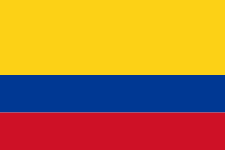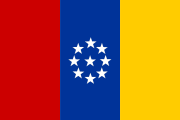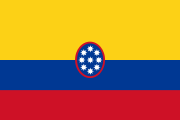- Flag of Colombia
-
Flag of Republic of Colombia
Name Tricolor Nacional (National tricolor) Use National flag and ensign 
Proportion 9:14 Adopted November 26, 1861 Design A triband flag with horizontal bands coloured yellow, blue and red. Horizontally the yellow occupies 50% and the other 50% is shared by the blue and red colors. Designed by Francisco de Miranda The flag of Colombia was adopted on November 26, 1861. It is a horizontal tricolour of yellow, blue and red. The yellow stripe takes up the top half of the flag and the blue and red take up a quarter of the space each.
Contents
Symbolism and design
 Flag of Colombia in Cartagena, Colombia.
Flag of Colombia in Cartagena, Colombia.
The horizontal stripes (from top to bottom) of yellow, blue and red tricolour have a ratio of 2:1:1. It—together with that of Ecuador, also derived from the flag of Gran Colombia—is different from most other tricolour flags, either vertical or horizontal, in having stripes which are not equal in size. (Venezuela, whose flag is also derived from the same source, opted for a more conventional tricolour with equal strips).
The official colours have not yet been established by law. However, it is recommended to use the following:
Scheme Yellow Blue Red Pantone 116 287 186 RGB 252-209-22 0-56-147 206-17-38 CMYK C0-M17.1-Y91.3-K0 C100-M61.9-Y0-K42.4 C0-M91.7-Y81.6-K19.2 HEX #FCD116 #003893 #CE1126 According to the current interpretation, the colours signify:
- Yellow: represents all the gold found in the Colombian land.
- Blue: represents the seas on Colombia's shores.
- Red: represents the blood spilled on the battlegrounds by the heroes who gained Colombia's freedom.
Other variations on the interpretation of the colours exist, such as, "Yellow, for the sun and land of the people. Blue, for the water that holds up the people and finally, Red, for the blood shed by the people who fought for the independence of Colombia."
Although there are no regulations stating the proportion of the flag, it traditionally is established at 2:3.
History
Francisco de Miranda was the person who originally created the common yellow, blue and red flag of Gran Colombia that Colombia, Ecuador and Venezuela, with slight variations, share today. Miranda gave at least two sources of inspiration for his flag. In a letter written to Count Simon Romanovich Woronzoff (Vorontsov) in 1792, Miranda stated that the colours were based on a theory of primary colours given to him by the German writer and philosopher Johann Wolfgang von Goethe. Miranda described a late-night conversation which he had with Goethe at a party in Weimar during the winter of 1785. Fascinated with Miranda's account of his exploits in the United States Revolutionary War and his travels throughout the Americas and Europe, Goethe told him that, "Your destiny is to create in your land a place where primary colours are not distorted.” He proceeded to clarify what he meant:
“ First he explained to me the way the iris transforms light into the three primary colours […] then he proved to me why yellow is the most warm, noble and closest to [white] light; why blue is that mix of excitement and serenity, a distance that evokes shadows; and why red is the exaltation of yellow and blue, the synthesis, the vanishing of light into shadow. It is not that the world is made of yellows, blues and reds; it is that in this manner, as if in an infinite combination of these three colours, we human beings see it. […] A country [Goethe concluded] starts out from a name and a flag, and it then becomes them, just as a man fulfils his destiny.
” After Miranda later designed his flag based on this conversation, he happily recalled seeing a fresco by Lazzaro Tavarone in the Palazzo Belimbau in Genoa that depicted Christopher Columbus unfurling a similar-coloured flag in Veragua during his fourth voyage.[1]
In his military diary, Miranda gave another possible source of inspiration: the yellow, blue and red standard of the Burger Guard (Bürgerwache) of Hamburg, which he also saw during his travels in Germany.[2][3]
In the 1801 plan for an army to liberate Spanish America, which he submitted unsuccessfully to the British cabinet, Miranda requested the materials for "ten flags, whose colours shall be red, yellow and blue, in three zones."[4] However, the first flag was not raised until March 12, 1806, in Jacmel, Haiti, during his ill-fated expedition to Venezuela.
Past flags





 Provisional flag of the State of New Granada. Flag ratio: 2:3
Provisional flag of the State of New Granada. Flag ratio: 2:3 Flag of the Republic of New Granada. Flag ratio: 2:3
Flag of the Republic of New Granada. Flag ratio: 2:3 Flag of the Granadine Confederation. Flag ratio: 2:3
Flag of the Granadine Confederation. Flag ratio: 2:3 Flag of the United States of New Granada. Flag ratio: 2:3
Flag of the United States of New Granada. Flag ratio: 2:3 Flag of the United States of Colombia. Flag ratio: 2:3
Flag of the United States of Colombia. Flag ratio: 2:31831 – 1834 1834 – 1858 1858 – 1861 1861 1861 – 1886 See also
References
- ^ Serpa Erazo, Jorge, [summary of Ricardo Silva Romero's] "La Bandera del Mundo." Pañol de la Historia. Part 1, Section 1 (July 30, 2004). ISSN 1900-3447. Retrieved on 2008-12-02
- ^ Dousdebés, Pedro Julio, "Las insignias de Colombia," Boletín de historia y antigüedades, August 1937, 462, cited in Nelson González Ortega, "Formación de la iconografía nacional en Colombia: una lectura semiótico-social," Revista de Estudios Colombianos, No. 16 (1996), 20.
- ^ Miranda, Francisco; Josefina Rodríguez de Alonso and José Luis Salcedo-Bastardo (1983), Colombeia: Segunda sección: El viajero ilustrado, 1787-1788, 4, Caracas: Ediciones de la Presidencia de la República, p. 415, ISBN 84-499-6610-8, "April 19:[…] around 5:30 in the evening I had the pleasure of seeing the Burger Guard pass by with flag waving and drums beating, which it does every day at a similar time […] The [officers of the] infantry wore red with a yellow emblem, and the artillery blue with red emblem."
- ^ Miranda, Francisco; Josefina Rodríguez de Alonso and José Luis Salcedo-Bastardo (1978), Colombeia: Primera parte: Miranda, súbdito español, 1750-1780, 1, Caracas: Ediciones de la Presidencia de la República, p. 80, ISBN 9788449951633
External links
 National symbols of Colombia
National symbols of ColombiaNational Anthem · Flag · Coat of Arms · Sombrero Vueltiao · Andean Condor · Carriel · Poporo Quimbaya · Wax Palm · May flower Orchid · Chiva Bus
Flags of South America Sovereign states Dependencies and
other territoriesNational flags and coats of arms National flags National coats of arms Categories:- Flags of Colombia
- National flags
- National symbols of Colombia
Wikimedia Foundation. 2010.






